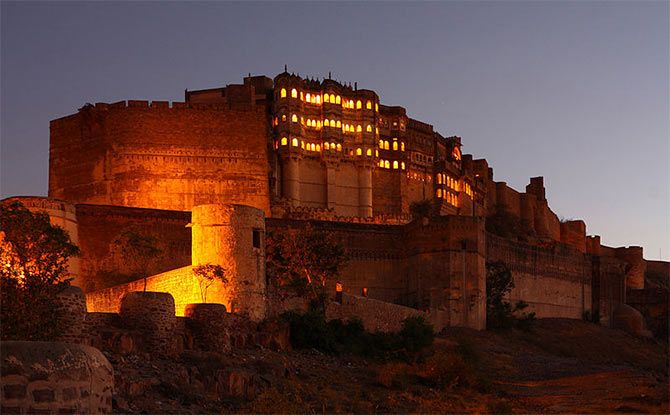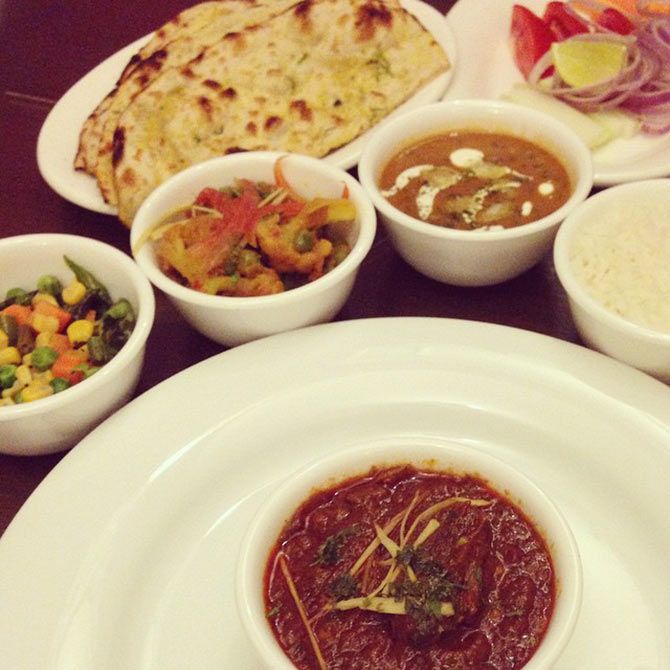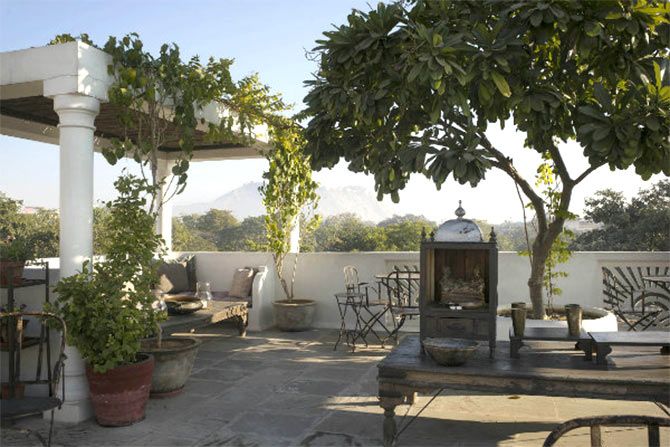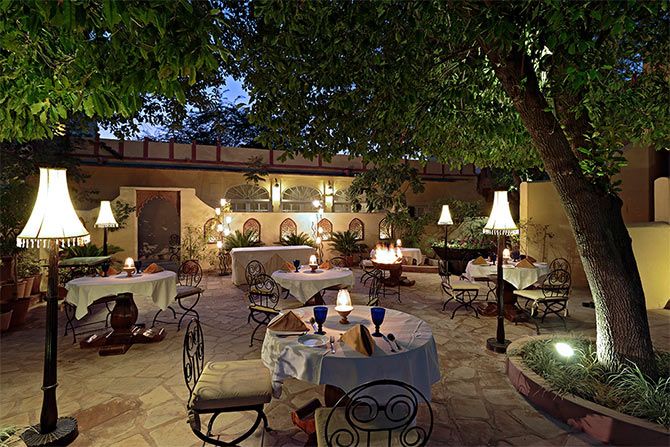 | « Back to article | Print this article |
The author revisits Jaipur, Jodhpur and Udaipur and finds them to be a medley of the old and new.

On Christmas Eve, a small group of Manganiar folk singers entertained guests on the lawns of Rohet Garh, a haveli hotel about 40 minutes from Jodhpur.
The typically high pitched voices of the well-known community of singers occasionally sounded as if they were singing falsetto.
The Manganiars are an instantly recognisable soundtrack of a stay at Rohet Garh.
A couple of weekends ago in Udaipur, the music could not have been more different.
On the opening evening of the World Music Festival in Udaipur, listeners were entertained by flamenco dancers and singers from Spain.
The dancers were Tamara Lucio and Juanma Zurano. Lucio's expressive dancing and extraordinary costumes were remarkable.
On occasion, the train on her gown, resembling the sort a princess would wear to get married, became a prop, swishing gracefully this way and that.
The singers from Seville communicated love and loss without us understanding a word of Spanish.
Both evenings highlighted why Rajasthan continues to charm instead of becoming a cliche, a postcard sent and received too often.
Its pull of magnificent palaces and forts and colourful customs is supplemented with new hotels and new cultural events that build on the success of the Jaipur Literature Festival.
The world music festival earlier this month, featured an acrobatic singer from the Ivory Coast and a fado singer from Portugal. A classical singer from Basel singing Gregorian chants paired off with a Carnatic singer for an unusual Sunday morning of devotional music.
Accompanying two sets of close friends from New York and London respectively, I was in Jodhpur in late December and Jaipur in early January. Initially, I tried to divert my guests from travelling to Rajasthan in peak season. I was proved wrong.
Arriving in Rohet Garh as the early evening sun cast a glow over its enormous garden, the hotel seemed lovelier than ever. I have stayed there thrice since 2002. On this visit, an expanded living room and lounge made it seem even more a home than a hotel.
It helps that the gracious owners, Rashmi and Sidharth Singh, live on the property and mingle in very relaxed fashion with the guests.
Sidharth Singh is a keen horseman, which makes it even more attractive for people who ride. (A few years ago, Madonna and her then husband were guests at Mihir Garh, a sister property nearby).
I mostly read in the garden, sometimes watching peacocks clumsily swoop on and off the trees, sometimes playing with the family's dogs.

The food is reason enough to be more active; Rohet Garh somehow serves all the Rajasthani staples such as laal maas and haldi ki subzi as well as delicious Western food.
Jaipur was familiar, but also a revelation.
My friends and I stayed at a new hotel owned by a jeweller. It's off the bustling road to the station; when Google maps is confounded by the task of finding it, the hotel dispatches a bell boy.

Jobner Bagh is a jewel, well worth the hunt; the sparkling white guesthouse seems like a villa transported from the seaside of Greece or Sicily.
The courtyard has charpoys and mooda chairs, the bedcovers show off stunning kantha work.
There is a gift shop selling scarves and bed covers and jewellery, often left unattended as a perverse test of guests' honesty. The terrace offers views of the Aravalli Hills, making you momentarily doubt you are in the city.
We went out for tea nearby to Jaipur's most famous kachori maker, drinking very rich cardamom flavoured milk on the side.
Our historical excursions were limited to Amer Fort. The conga line of elephants carrying tourists as well as open air jeeps made the excursion by foot seem like a journey from another era.
I longed to come back at night, which travellers are now able to do, but my friends were bound that afternoon for Samode Palace, a fairy tale that masquerades as a hotel, and I had work to return to in New Delhi.
Part of the trick in Rajasthan is to find time to visit the monuments when the crowds aren't doing so.
My most memorable visit to the magnificent Mehrangarh fort was at the height of summer three years ago when friends and I had it almost to ourselves. By contrast, on Christmas day last year, it felt the site of a non-violent but very noisy invasion.
I retreated to its ramparts to survey this fort that Rudyard Kipling's father thought could only have been built by giants.
On repeat visits to Udaipur, I have done little more than look at the reflections of palaces and havelis off its lake.

This time, I rushed about the city like a commuter late for work. For anyone who loves African music, Dobet Gnahore from the Ivory Coast was a treat.
She emits hyperkinetic energy, singing and dancing with athleticism so intense that she wears protective knee braces.
Chief Minister Vasundhara Raje was in the audience. The following day, Sonam Kalra's Sufi Gospel Project had an important message of tolerance and syncretism for our times. She sang songs based on the work of the great Sufi poet Bulleh Shah and closed with Leonard Cohen.
The young audience is part of what makes the Jaipur Literature Festival such fun.
They were at the world music festival in large numbers, too. "We love you, ma'am," shouted some college kids after Kalra's set. It was time for my friends and I to leave for the airport, but the packed afternoon concert made me determined to return. Against the odds, Rajasthan still rocks.